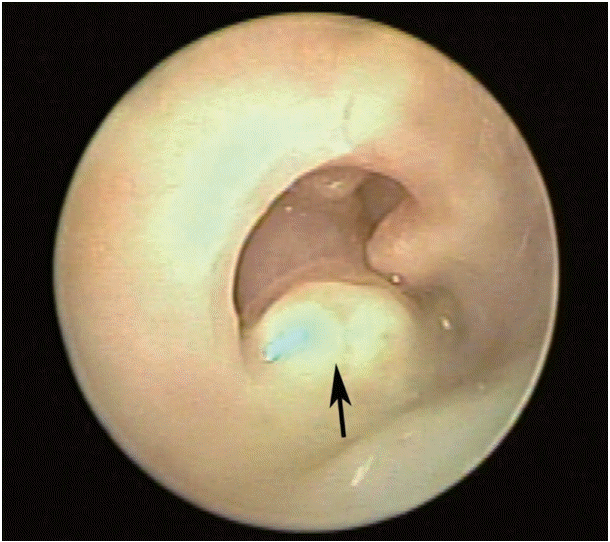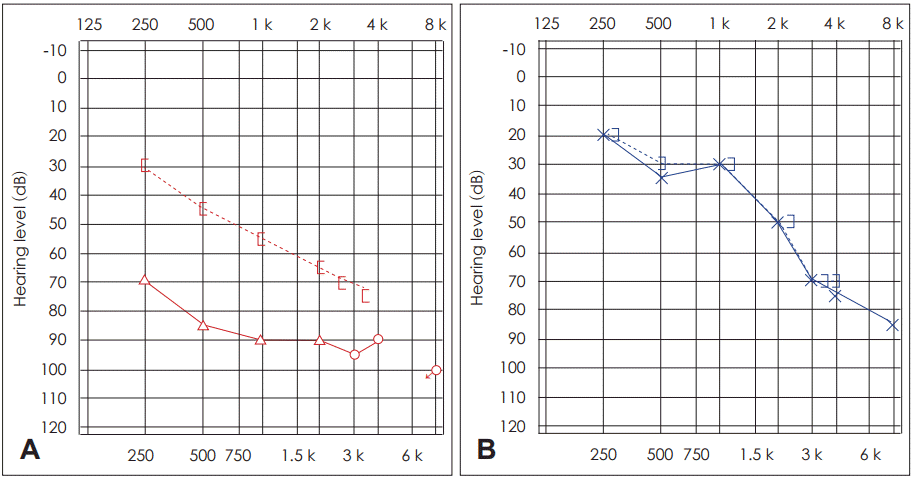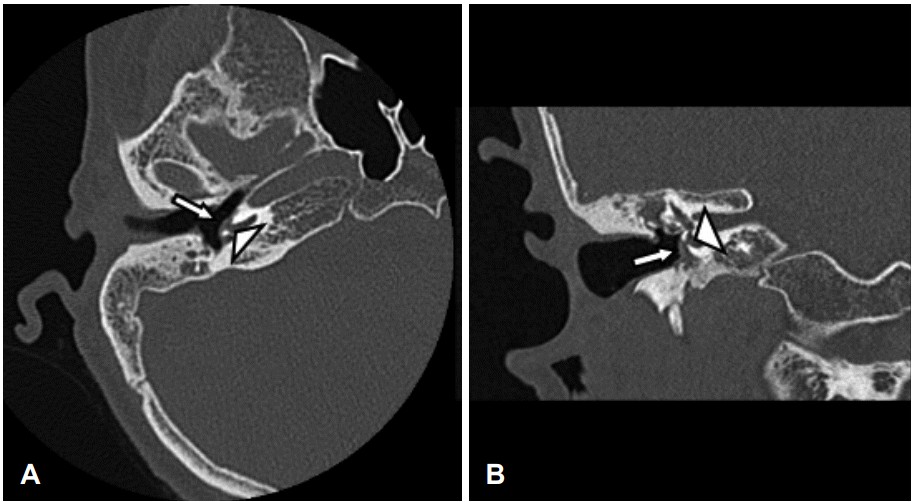 |
 |
- Search
| J Audiol Otol > Volume 21(2); 2017 > Article |
|
Abstract
Cochlear fistula in the chronic otitis media (COM) without cholesteatoma is an extremely rare with only a few cases reported in the literature to this date. We describe a case of cochlear fistula observed in a female with COM without cholesteatoma. This report presents the first clinical case of a transtympanic iatrogenic trauma by habitual cotton swabs probably causing cochlear fistula.
Cochlear fistula in the chronic otitis media (COM) without cholesteatoma is an extremely rare with only a few cases reported in the literature to this date [1-3]. We describe a case of cochlear fistula observed in a female patient with COM without cholesteatoma. This report presents the first clinical case of a transtympanic iatrogenic trauma by habitual cotton swabs probably causing cochlear fistula. Approval for this report was obtained from Inje University Sanggye Paik Hospital Institutional Review Board (IRB No. SGPIAK 2016-11-011).
A 69-year-old woman presented at our hospital with 20-year history of right-side hearing impairment, otorrhea, ear fullness and tinnitus without vertigo. She habitually used cotton swabs for cleaning her ear due to frequent episodes of otorrhea and she also reported that she put cotton swaps deeply for some relief of ear fullness. She had a medical history of hypertension and diabetes mellitus. On physical examination, a perforation of the tympanic membrane with granulation tissue was observed. The mucosa of the tympanic cavity especially above the promontory was very thick (Fig. 1). A puretone audiogram (PTA) showed right mixed type hearing loss with 55 decibels (dB) of bone conduction (BC) threshold and 90 dB of air conduction (AC) threshold. In comparison, the PTA in the left side was 36 dB of BC threshold and 46 dB of AC threshold (Fig. 2). Bacterial examination of the otorrhea subsequently yielded methicillin-resistant Staphylococcus epidermidis. High-resolution computed tomography (CT) was compatible with COM without cholesteatoma.
The patient went through surgery for COM via a postauricular approach. A canal-wall-up tympanomastoidectomy was performed. During the operation, a hard thickened mucosa was observed at the cochlear promontory. In removing the thickened tissue around promontory, above which fluctuation of the mucosa was noticed. An unconfirmed diagnosis of cochlear fistula was made and then CT was reviewed thoroughly. It showed bony defect of the first turn of the cochlea (Fig. 3). During the operation, the intact endosteum of the cochlea was noticed. Temporalis fascia was placed over the dehiscent cochlea. We did not find any other cholesteatoma lesions in the middle ear cavity. She did not complain of dizziness and further hearing loss after surgery.
Cochlear fistula in the COM without cholesteatoma is an extremely rare with only a few cases reported in the literature to this date [1-3]. The promontory is not usual site of bone destruction. It is very dense and not the common site of keratin accumulation and pressure necrosis even in COM with cholesteatoma unlike lateral semicircular canal.
In the COM with cholesteatoma, various mechanisms of bone erosion have been suggested. Besides pressure ischemia [4], other factors such as pH alterations, the activity of osteoclasts, production of osteolytic enzymes by the matrix of cholesteatoma, or a combination of the above been considered to play a role in bone resorption [5-7].
In this case of COM without cholesteatoma, repeated mechanical irritation such as habitual cotton swabs may cause chronic mucosal trauma and continuous inflammation in the cochlear promontary. Furthermore, inflammatory mediators induced bony remodeling in cochlear promontory. As a result, those processes might lead to the cochlear fistula.
Sensorineural hearing loss in COM can be related to either mechanical or chemical iirritaions. Mechanical damage may include continuous trauma to the membranous labyrinth, leading to fistula formation between the endolymph and perilymph, causing a loss of hearing [8,9]. Chemical damage can be caused by the penetration of noxious substances such as bacterial toxins into the labyrinth. Endogenous toxins that may be present in middle ear effusions (lipopolysaccharides, prostaglandins, and leukotrienes) are also possible mediators of sensorineural hearing loss [10-13].
However, our patientŌĆÖs BC was relatively preserved. There are several hypotheses regarding the mechanism of hearing preservation. Natural segmentation of the labyrinth, a kind of anatomic adaptation, might prevent loss of endolymph [14].
When the cochlear endosteum was invaded by the cholesteatoma or was damaged during surgery, severe hearing loss occurred [14].
In the reported cases, the membranous labyrinth was left intact with preserved BC [15], even though membranous labyrinth conservation is not always synonymous with hearing preservation.
Chronic irritations by mechanical stimulation and inflammatory mediators may also cause local changes around the fistula such as thickening the endosteum of the cochlea and protecting involvement of membranous labyrinth. But further irritation at the endosteum could cause the hearing loss. A thick mucosal layer covered the unexpected small bone dehiscence of the promontory and, fortunately, its removal did not cause a lesion of the endosteum, allowing preservation of BC.
However, further evaluation is needed to find exact pathologic mechanism among mechanical irritation, cochlear fistula and hearing preservation.
In conclusion, cochlear fistula can also be observed in COM without cholesteatoma. It cannot be emphasized enough that CT should be read thoroughly preoperatively even in the COM without cholesteatoma case. The presence of a fistula is not always associated with severe hearing loss, so every effort should be made to not damage the membranous labyrinth. Inflammatory tissue or cholesteatoma matrix can be removed from the fistulous tract without injuring the membranous labyrinth. If any doubt of damaging the membranous labyrinth exists, the matrix must be exteriorized and long-term follow-up is strongly recommended.
Therefore, even in COM without cholesteatoma, tympanoplasty would be recommended for preventing cochlear damage.
Fig.┬Ā1.
Otoendoscopic view, right ear. The perforation of the tympanic membrane with granulation tissue and very thickened remnant of tympanic membrane and mucosa of the tympanic cavity especially above the promontory (arrow) with serous discharge were observed.

REFERENCES
1. de Zinis LO, Campovecchi C, Gadola E. Fistula of the cochlear labyrinth in noncholesteatomatous chronic otitis media. Otol Neurotol 2005;26:830ŌĆō3.


2. Hahn Y, Bojrab DI. Cochlear fistula in a noncholesteatomatous ear. Ear Nose Throat J 2014;93:E9ŌĆō10.

3. Sakaida H, Takeuchi K. Cochlear fistula as a late consequence of tympanomastoidectomy. Otol Neurotol 2015;36:e148ŌĆō9.


4. Abramson M, Harker LA, McCabe BF. Labyrinithine fistula complicating chronic suppurative otitis media. Arch Otolaryngol 1974;100:141ŌĆō2.


5. Hansen T, Unger RE, Gaumann A, Hundorf I, Maurer J, Kirkpatrick CJ, et al. Expression of matrix-degrading cysteine proteinase cathepsin K in cholesteatoma. Mod Pathol 2001;14:1226ŌĆō31.


6. Uno Y, Saito R. Bone resorption in human cholesteatoma: morphological study with scanning electron microscopy. Ann Otol Rhinol Laryngol 1995;104:463ŌĆō8.


7. Hamzei M, Ventriglia G, Hagnia M, Antonopolous A, Bernal-Sprekelsen M, Dazert S, et al. Osteoclast stimulating and differentiating factors in human cholesteatoma. Laryngoscope 2003;113:436ŌĆō42.


8. Ars B, Claes J, Casselman J, Ars-Piret N. Preservation of cochlear function after extensive labyrinthine destruction. Am J Otol 1996;17:40ŌĆō5.

9. Eisenman DJ, Parisier SC. Is chronic otitis media with cholesteatoma associated with neurosensory hearing loss? Am J Otol 1998;19:20ŌĆō5.

10. Stenqvist M, Anniko M, Pettersson A. Effect of Pseudomonas aeruginosa exotoxin A on inner ear function. Acta Otolaryngol 1997;117:73ŌĆō9.


11. Engel F, Blatz R, Kellner J, Palmer M, Weller U, Bhadki S. Breakdown of the round window membrane permeability barrier evoked by streptolysin O: possible etiologic role in development of sensorineural hearing loss in acute otitis media. Infect Immun 1995;63:1305ŌĆō10.



12. Guo Y, Wu Y, Chen W, Lin J. Endotoxic damage to the stria vascularis: the pathogenesis of sensorineural hearing loss secondary to otitis media? J Laryngol Otol 1994;108:310ŌĆō3.


13. Papp Z, Rezes S, J├│kay I, Sziklai I. Sensorineural hearing loss in chronic otitis media. Otol Neurotol 2003;24:141ŌĆō4.










